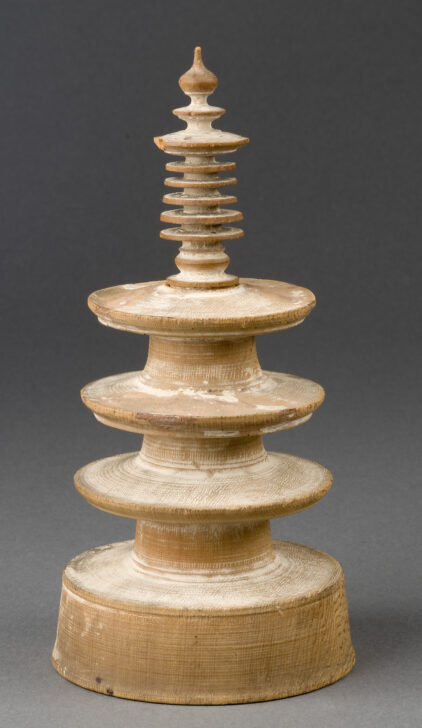Stupa: Hyakuman tô (one of one million pagodas)
Japanese

Description
Stupa: Hyakuman to ̄ (one of
one million pagodas)
Japan
Nara period (710–794)
764–70
Carved wood with traces of gesso
Museum purchase made possible by the
Margaret Watson Parker Art Collection
Fund, 1969/2.21
In the fi nal years of her reign, the empress Ko ̄ken
commissioned one million wooden stupas
(pagodas), each containing a short Buddhist ritual
phrase known as a dharani, as a personal and public
devotion. These objects were distributed to the
most powerful temples in Nara, the capital of Japan
during her reign. We do not know how many were
produced, but most extant examples were housed in
the temple of Ho ̄ryu ̄-ji.
Perhaps the most noteworthy aspect of Ko ̄ken’s
project is the printing of the dharani, which ranks
among the earliest examples of a mass-produced
text. The technology, which used woodblocks or
bronze plates, was developed in China. The text
included with this stupa is from the Dharani of the
Pure Immaculate Light (Japanese: Mukujo ̄ko ̄ darani
. The sutra from which it comes
encourages copying dharani to ensure a long life,
karmic benefi ts, and rebirth in a Buddhist heaven.
Subject Matter:
This miniature wooden stupa, or pagoda, is one of one million Buddhist small stupas commissioned by Kôken (718–770), Empress Regnant of Japan (r. 749-758), to celebrate her triumph in 764 over Fujiwara Nakamaro, whose rebellion had earlier forced her from the throne. The central axis of the stupa would have been hollowed out to contain a dharani, a powerful Buddhist prayer, which amimates and sacralizes the stupa.
Physical Description:
Wooden miniture model of a tower, comprised of a round base, a bar in the middle where three larger discs and six or seven small discs are inserted. A bulb-shaped ornament rests on top.
Usage Rights:
If you are interested in using an image for a publication, please visit https://umma.umich.edu/request-image/ for more information and to fill out the online Image Rights and Reproductions Request Form.